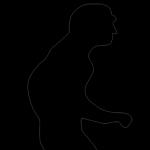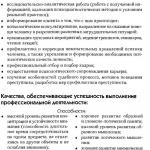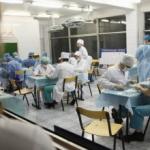Application of bionics. Bionics - what kind of science is it? What does bionics study? Application of bionics Pros and cons of the profession
Beginning:39000 per month

Experienced: 50000 per month

Professional: 65000 per month
Demand for the profession
Currently, many companies are interested in specialists in the field of bionics. Therefore, a professional bionicist will not be left without employment. Research in this area continues.
Where to study for the Bionics profession in Moscow
Who is the profession suitable for?
Important personal qualities:
- creative thinking
- good memory
- attentiveness
- inventor's abilities
- responsibility
Career
Typically, companies developing new technologies are interested in stimulating the work of their employees and reward them well for new ideas and proposals. Therefore, a bionicist can qualify for a high salary.
Responsibilities
- studying the nervous system of humans and animals and modeling nerve cells (neurons) and neural networks for further improvement of computer technology and the development of new elements and devices of automation and telemechanics (neurobionics);
- research into the sense organs and other perceptive systems of living organisms in order to develop new sensors and detection systems;
- studying the principles of orientation, location and navigation in various animals for the use of these principles in technology;
- study of the morphological, physiological, biochemical characteristics of living organisms to put forward new technical and scientific ideas.
Specialist in the field of bionics (a scientific discipline related to the search for solutions to various engineering problems based on analysis of the structure and vital functions of organisms).
Job responsibilities
Bionics is therefore closely related to both biology, physics, chemistry, cybernetics, and engineering disciplines - electronics, communications, navigation, etc. Among the main areas of work in bionics are the study of the nervous system and modeling of nerve cells and connections between them in order to improve computer technology and develop new elements and devices of automation and telemechanics (neurobionics); research of sensory organs in order to create various sensors and detection systems; studying the principles of orientation, location and navigation in animals for their use in technology. An important place in bionics is given to the study of the morphological characteristics of living organisms in order to put forward new technical and scientific ideas - for example, the study of the skin of high-speed aquatic animals (for example, a dolphin) made it possible to create a special skin for ships and thereby increase their speed by 15-20% . By studying the flight of birds and insects, the movements of jumping animals, the structure of joints, etc., bionicists are developing new principles of flight, wheelless movement, the construction of bearings, and various manipulators. The range of methods used by bionics is thus extremely wide - from classical methods of anatomical preparation to the creation of mathematical models of the phenomena and structures being studied. Bionicists have to work with a scalpel and a soldering iron, an entomological net and a slide rule. Their broad general biological and ethological erudition must be combined with thorough mathematical training, the ability to find extraordinary engineering solutions, and a taste for technical design.
The slogan of bionics is: “Nature knows best.” What kind of science is this? The name itself and this motto make us understand that bionics is connected with nature. Many of us encounter elements and results of the science of bionics every day without even knowing it.
Have you heard of such a science as bionics?
Biology is a popular knowledge that we are introduced to at school. For some reason, many people believe that bionics is one of the subfields of biology. In fact, this statement is not entirely accurate. Indeed, in the narrow sense of the word, bionics is a science that studies living organisms. But most often we are accustomed to associate something else with this teaching. Applied bionics is a science that combines biology and technology.
Subject and object of bionic research
What does bionics study? To answer this question, we need to consider the structural division of the teaching itself.
Biological bionics explores nature as it is, without attempting to interfere. The object of its study is the processes occurring inside
Theoretical bionics deals with the study of those principles that have been noticed in nature, and on their basis creates a theoretical model, which is subsequently used in technology.
Practical (technical) bionics is the application of theoretical models in practice. So to speak, the practical introduction of nature into the technical world.
Where did it all start?
The great Leonardo da Vinci is called the father of bionics. In the notes of this genius one can find the first attempts at the technical implementation of natural mechanisms. Da Vinci's drawings illustrate his desire to create an aircraft capable of moving its wings, like a bird flying. At one time, such ideas were too daring to become popular. They attracted attention much later.
The first person to apply the principles of bionics in architecture was Antoni Gaudí i Cournet. His name is firmly imprinted in the history of this science. Architectural structures designed by the great Gaudi were impressive at the time of their construction, and they evoke the same delight many years later among modern observers.

The next person to support the idea of the symbiosis of nature and technology was Under his leadership, the widespread use of bionic principles in building design began.
The approval of bionics as an independent science occurred only in 1960 at a scientific symposium in Daytona.
The development of computer technology and mathematical modeling allows modern architects to implement nature’s cues in architecture and other industries much faster and with greater accuracy.
Natural prototypes of technical inventions
The simplest example of the science of bionics is the invention of hinges. The fastening is familiar to everyone, based on the principle of rotation of one part of the structure around another. This principle is used by seashells in order to control their two valves and open or close them as needed. Pacific giant heartfish reach sizes of 15-20 cm. The hinged principle in connecting their shells is clearly visible to the naked eye. Small representatives of this species use the same method of fixing the valves.
In everyday life, we often use a variety of tweezers. The sharp and pincer-shaped beak of the godwit becomes a natural analogue of such a device. These birds use a thin beak, sticking it into soft soil and taking out small beetles, worms, etc.
Many modern devices and devices are equipped with suction cups. For example, they are used to improve the design of the legs of various kitchen appliances to prevent them from slipping during operation. Suction cups are also used to equip the special shoes of window cleaners in high-rise buildings to ensure their safe fixation. This simple device is also borrowed from nature. The tree frog, having suction cups on its legs, stays unusually deftly on the smooth and slippery leaves of plants, and the octopus needs them for close contact with its victims.

You can find many such examples. Bionics is precisely the science that helps people borrow technical solutions from nature for their inventions.
Who comes first - nature or people?
Sometimes it happens that one or another invention of mankind has long been “patented” by nature. That is, inventors, when creating something, do not copy, but come up with the technology or operating principle themselves, and later it turns out that it has existed in nature for a long time, and one could simply spy on it and adopt it.
This happened with the usual Velcro fastener, which is used by a person to fasten clothes. It has been proven that hooks, similar to those found on Velcro, are also used to connect thin barbs together.
The structure of factory chimneys is similar to the hollow stems of cereals. The longitudinal reinforcement used in pipes is similar to the sclerenchyma strands in the stem. Steel stiffening rings - interstices. The thin skin on the outside of the stem is an analogue of spiral reinforcement in the structure of pipes. Despite the colossal similarity of structure, scientists independently invented just such a method for constructing factory pipes, and only later saw the identity of such a structure with natural elements.
Bionics and medicine
The use of bionics in medicine makes it possible to save the lives of many patients. Without stopping, work is underway to create artificial organs capable of functioning in symbiosis with the human body.

Dane Dennis Aabo was the first to test it. He lost half his arm, but now has the ability to perceive objects by touch with the help of a medical invention. His prosthesis is connected to the nerve endings of the injured limb. Artificial finger sensors are capable of collecting information about touching objects and transmitting it to the brain. The design has not yet been finalized; it is very bulky, which makes it difficult to use in everyday life, but now we can call this technology a real discovery.
All research in this direction is entirely based on copying natural processes and mechanisms and their technical implementation. This is medical bionics. Reviews from scientists say that their work will soon make it possible to replace worn-out living human organs and use mechanical prototypes instead. This will truly be the greatest breakthrough in medicine.
Bionics in architecture
Architectural and construction bionics is a special branch of bionic science, the task of which is the organic reunification of architecture and nature. Recently, more and more often, when designing modern structures, they are turning to bionic principles borrowed from living organisms.
Today, architectural bionics has become a separate architectural style. It was born from a simple copying of forms, and now the task of this science has become to adopt the principles, organizational features and technically implement them.

Sometimes this architectural style is called eco-style. This is because the basic rules of bionics are:
- search for optimal solutions;
- principle of saving materials;
- the principle of maximum environmental friendliness;
- principle of energy saving.
As you can see, bionics in architecture are not only impressive forms, but also progressive technologies that make it possible to create a structure that meets modern requirements.
Characteristics of architectural bionic buildings
Based on past experience in architecture and construction, we can say that all human structures are fragile and short-lived if they do not use the laws of nature. Bionic buildings, in addition to amazing shapes and bold architectural solutions, are resilient and able to withstand adverse natural phenomena and disasters.
In the exterior of buildings built in this style, one can see elements of reliefs, shapes, and contours, skillfully copied by design engineers from living, natural objects and masterfully embodied by building architects.
If suddenly, when contemplating an architectural object, it seems that you are looking at a work of art, there is a high probability that in front of you is a building in the bionic style. Examples of such structures can be seen in almost all capitals of countries and large technologically advanced cities of the world.

Design for the new millennium
Back in the 90s, a Spanish team of architects created a building project based on a completely new concept. This is a 300-story building, the height of which will exceed 1200 m. It is planned that movement along this tower will take place using four hundred vertical and horizontal elevators, the speed of which is 15 m/s. The country that agreed to sponsor this project was China. The most populous city, Shanghai, was chosen for construction. The implementation of the project will solve the demographic problem of the region.
The tower will have a completely bionic structure. Architects believe that only this can ensure the strength and durability of the structure. The prototype of the structure is a cypress tree. The architectural composition will have not only a cylindrical shape, similar to a tree trunk, but also “roots” - a new type of bionic foundation.
The outer covering of the building is a plastic and breathable material that imitates tree bark. The air conditioning system of this vertical city will be analogous to the heat-regulating function of the skin.
According to scientists and architects, such a building will not remain the only one of its kind. After successful implementation, the number of bionic buildings in the architecture of the planet will only increase.

Bionic buildings around us
What famous creations have used the science of bionics? Examples of such structures are easy to find. Take, for example, the process of creating the Eiffel Tower. For a long time there were rumors that this 300-meter symbol of France was built according to the drawings of an unknown Arab engineer. Later, its complete analogy with the structure of the human tibia was revealed.
In addition to the Eiffel Tower, you can find many examples of bionic structures all over the world:
- was erected by analogy with a lotus flower.
- Beijing National Opera House - imitation water drop.
- Swimming complex in Beijing. Externally it repeats the crystalline structure of the water lattice. An amazing design solution also combines the useful ability of the structure to accumulate solar energy and subsequently use it to power all electrical appliances operating in the building.
- The Aqua skyscraper looks like a stream of falling water. Located in Chicago.
- The house of the founder of architectural bionics, Antonio Gaudi, is one of the first bionic structures. To this day, it has retained its aesthetic value and remains one of the most popular tourist sites in Barcelona.
Knowledge everyone needs
Summing up, we can safely say: everything that bionics studies is relevant and necessary for the development of modern society. Everyone should become familiar with the scientific principles of bionics. Without this science it is impossible to imagine technical progress in many areas of human activity. Bionics is our future in complete harmony with nature.
2. Artificial organs
2.2. Artificial eye
2.3. Artificial ear
2.4. Artificial nose
2.5. Constructed language
2.6. Faux leather
3. Nanotechnology in medicine
4.2. Beetles are rescuers
5. Military technology
5.1. Smart dust
5.4. Condition monitoring...
More about the program
1. Introduction: What is bionics and why is it needed?
2. Artificial organs
2.1. Artificial body (sense organs)
2.2. Artificial eye
2.3. Artificial ear
2.4. Artificial nose
2.5. Constructed language
2.6. Faux leather
3. Nanotechnology in medicine
3.1. Chipping living organisms using nanotechnology
3.2. Nanorobots - drug delivery service
3.3. Brain monitoring sensor
4. Cyborgs: control of biological objects
4.1. Cockroaches and mosquitoes join the fight against terrorism
4.2. Beetles are rescuers
4.3. Beetles - liquidators of environmental disasters
4.4. New uniforms for the insect special forces
5. Military technology
5.1. Smart dust
5.2. Liquid armor, invisibility cloak
5.3. Monitoring the parameters of the human body
5.4. Monitoring the health status of personnel
6. Conclusion
Why do I need this course?
1. Familiarization with modern technologies, equipment and scientific trends
2. For the development of scientific and technical thinking
3. Applicants understand what awaits them at the university
4. Bachelors receive the knowledge necessary when choosing a scientific direction in master's and postgraduate studies.
Bonuses:
1. Upon completion of the course, all students receive a personal certificate.
2. This certificate will decorate your resume, as this is the most promising and sought-after area in the modern scientific and technical world.
3. This certificate gives the right to participate in the international conference for schoolchildren, bachelors, masters, graduate students and young scientists "Nanoindustry and technologies of the future."
4. When entering St. Petersburg State Technical University "LETI" for a budgetary full-time course of study, this certificate gives you the right to receive an increased scholarship for 1 semester and the possibility of priority enrollment in the "elite groups".
5. This certificate gives the right to enter into the research activities of St. Petersburg Electrotechnical University "LETI" under the guidance of world-class scientists.
Bionics is a science that studies living nature with the aim of using the acquired knowledge in practical human activities. Problems of bionics: the study of the patterns of structure and function of individual parts of living organisms (nervous system, analyzers, wings, skin) with the aim of creating on this basis a new type of computer, locator, flying, swimming apparatus, etc.; studying bioenergetics to create fuel-efficient muscle-like engines; research into the processes of biosynthesis of substances with the aim of developing relevant branches of chemistry. Bionics is closely related to technical (electronics, communications, maritime affairs, etc.) and natural science (medicine) disciplines, as well as cybernetics (see).
Bionics (English bionics, from bion - living creature, organism; Greek Bioo - live) is a science that studies living nature with the aim of using the acquired knowledge in practical human activities.
The term bionics first appeared in 1960, when specialists from various fields who gathered at a symposium in Daytona (USA) put forward the slogan: “Living prototypes are the key to new technology.” Bionics was a kind of bridge that connected biology with mathematics, physics, chemistry and technology. One of the most important goals of bionics is to establish analogies between the physicochemical and information processes found in technology and the corresponding processes in living nature. A bionics specialist is attracted by the variety of “technical ideas” developed by living nature over many millions of years of evolution. A special place among the tasks of bionics is occupied by the development and construction of control and communication systems based on the use of knowledge from biology. This is bionics in the narrow sense of the word. Bionics is important for cybernetics, radio electronics, aeronautics, biology, medicine, chemistry, materials science, construction and architecture, etc. The tasks of bionics also include the development of biological methods of mining, technologies for the production of complex substances of organic chemistry, building materials and coatings, which used by wildlife. Bionics teaches the art of rational copying of living nature, finding technical conditions for the appropriate use of biological objects, processes and phenomena.
One of the possible ways here is functional (mathematical or software) modeling, which consists in studying the structural diagram of the process, the functions of the object, the numerical characteristics of these functions, their purpose and changes over time. This approach makes it possible to study the process of interest using mathematical means, and to carry out the technical implementation of the model when its effectiveness has been established in principle and it remains to check the economic, energy and other possibilities of constructing this kind of model using the available technical means. There is another way - physical and chemical modeling, when a specialist in the field of bionics studies biochemical and biophysical processes in order to study the principles of transformation (including decomposition and synthesis) of substances occurring in a living organism. This path is most closely related to chemical-technological issues and opens up new opportunities in the development of energy and polymer chemistry. The third approach developed by bionics is the direct use of living systems and biological mechanisms in technical systems. This approach is usually called the inverse modeling method, since in this case a bionic specialist seeks the possibilities and conditions for adapting living systems to solve purely engineering problems, in other words, he tries to simulate a technical device or process on a biological object. Emerging in response to requests from practice, bionics served as the beginning of research based on the application of biological knowledge in all areas of technology. Its main result is to establish the first ways for the ever-increasing technical mastery of biology.





